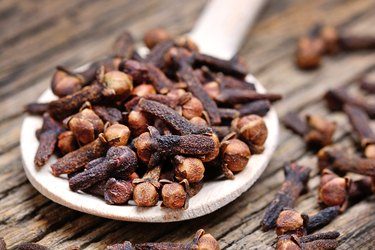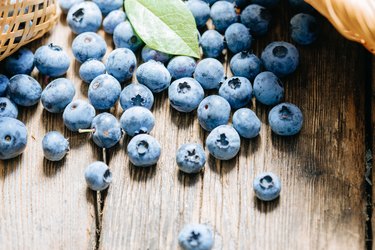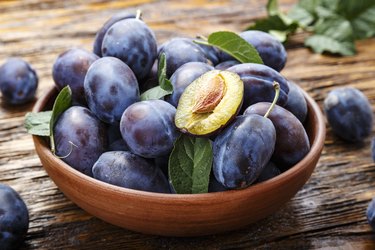If you're trying to eat healthier, enriching your diet with foods high in polyphenols is a good place to start. Polyphenols are naturally occurring chemical compounds that boast antioxidant properties.
Research has shown that diets rich in foods containing polyphenols are linked to lower rates of heart diseases, cancer, neurodegenerative disease and diabetes, per the University of Texas Southwestern Medical Center. What's more, foods high in antioxidants like polyphenols may also guard your skin from free radical damage, according to the Cleveland Clinic.
Video of the Day
Video of the Day
Here are a few common types of polyphenols, per the University of Nebraska Lincoln:
- Phenolic acid
- Stilbenes
- Lignans
- Flavonoids
- Antoxanthines
- * Flavonols
- Quercetin
- Catechin
- Luteolin
- Antoxanthines
- Anthocyanins
- * Cyanidin
What Are Phenols?
The term phenol refers to a large group of chemical compounds found in plants. These chemicals help to protect the plant from bacterial and fungal infections and UV radiation damage, per an October 2010 study in Molecules. Phenols in food are often in the form of polyphenols.
Below, find a list of foods high in polyphenols based on a widely cited November 2020 study in the European Journal of Clinical Nutrition.
In this comprehensive report, researchers identified the 100 richest dietary sources of polyphenols. They measured polyphenols in milligrams per 100 grams (3.5 ounces) of each food, which is how you'll see polyphenol content represented in this list.
But, keep in mind that this is just a way to measure the concentration of polyphenols in given foods. You'd likely only have a gram or two of seasonings like cloves at a given meal, but you'll easily eat more than 100 grams of blueberries or strawberries in a serving.
How Many Polyphenols Do You Need Per Day?
The Dietary Guidelines for Americans do not specify a Daily Value (DV) for polyphenols. That said, a diet rich in antioxidant polyphenols is linked to longevity, according to a September 2013 study in The Journal of Nutrition. Eating a wide variety of plant-based foods will help you get plenty of polyphenols.
1. Cloves: 15,188 mg

Seasonings like cloves have the highest concentration of polyphenols, with 15,188 milligrams per 100 grams (though you'd likely only have about a teaspoon, or 2 grams, in a given dish). Cloves contain high amounts of the phenolic flavor eugenol, per the European Journal of Clinical Nutrition study.
Eugenol is also known as clove oil, which has been touted as useful for toothache, cleaning teeth and freshening breath, according to the National Institutes of Health (NIH). However, it's always best to get your antioxidants from foods rather than supplements: High doses of clove oil can cause severe liver injury.
Other seasonings high in polyphenols include dried peppermint, star anise, Mexican oregano and celery seed.
2. Dark Chocolate: 1,664 mg
Antioxidant-rich dark chocolate has 1,664 milligrams of polyphenols per 100 grams. The serving size of chocolate is typically 28 grams (1 ounce).
Most of the polyphenols in dark chocolate and cocoa are flavonols, per an April 2020 study in The FASEB Journal. Eating dark chocolate is tied to lower blood pressure, improved insulin sensitivity, decreased total blood cholesterol (particularly "bad" LDL cholesterol) and improved vascular inflammation.
Balance is key, though: One ounce of dark chocolate contains 170 calories and 6.8 grams of sugar, or 14 percent of the DV. Eating too much dark chocolate could cause you to overload on calories and sugar, potentially leading to weight gain, so try sticking to one square a day.
3. Flaxseed Meal: 1,528 mg
Flaxseed is highly concentrated in polyphenols, with 1,528 milligrams per 100 grams. In particular, it is high in the lignan secoisolariciresinol, per the European Journal of Clinical Nutrition study. A serving size of ground flaxseed is 1 tablespoon, or 7 grams.
Lignans have a steroid-like chemical structure and are known as phytoestrogens. They have traditionally been linked to health benefits such as a lowered risk of heart disease, menopausal symptoms, osteoporosis and breast cancer, per a March 2019 review in the journal Molecules.
Experts recommend flaxseed meal (ground flaxseed) over whole flaxseed because it is easier to digest and your body will absorb more nutrients from it, according to the Mayo Clinic.
Should You Look for Foods High In Polyphenols but Low in Lectins?
Lectins are naturally occurring proteins found in many plant foods, including beans, peanuts, tomatoes, lentils, eggplant, wheat and other grains, per the Mayo Clinic.
Some people think avoiding lectins helps promote weight loss or cure health problems, but no scientific evidence exists to support these claims. While lectins in certain raw foods (like beans) have the potential to be harmful, you typically wouldn’t eat enough of them to cause concern. But some people with gastrointestinal problems may avoid foods with lectins because they may irritate digestive issues like IBS, per the Harvard T.H. Chan School of Public Health.
4. Chestnuts: 1,215 mg
Chestnuts — with 1,215 milligrams of polyphenols per 100 grams — are rich in ellagitannins, polyphenols that have strong potential for preventing or even treating various types of cancer, per a May 2016 study in the journal Toxins.
Plus, 1 ounce of chestnuts (28 grams) contains 13 percent of the DV for the antioxidant vitamin C. People between the ages of 55 and 69 who ate at least 10 grams of tree nuts or peanuts (about 1/2 handful) every day had a lower risk of death from major causes like respiratory disease, cancer, diabetes and heart disease than those who did not eat nuts or peanuts, per a May 2015 study in the International Journal of Epidemiology.
5. Wild Blueberries: 836 mg

Wild blueberries have an even higher concentration of polyphenols (836 milligrams per 100 grams) than conventional blueberries (560 milligrams per 100 grams), according to the European Journal of Clinical Nutrition study.
Blueberries are especially high in anthocyanins, a type of polyphenol responsible for the red, purple and blue colors in fruits and vegetables, per an August 2017 study in Food & Nutrition Research.
Research shows that anthocyanins are linked to lower blood pressure, reduced cancer cell growth, diabetes prevention, improved vision and a lower risk of heart disease, per an October 2015 report in the Journal of Food Processing & Technology. Try them in these healthy blueberry breakfast recipes.
Tip
To pick fruits with the highest level of phenols, aim for the berry family. Other fruits to reach for are citrus varieties, apples, peaches, apricots, plums, pears, grapes and cherries.
When selecting fruits based on phenol content, note that the darker the fruit, the greater the phenol content. By eating the seeds and skins, you get the most phenols from plant foods.
6. Black Olives: 569 mg
Black and green olives are the richest vegetable sources of polyphenols (569 milligrams per 100 grams), particularly tyrosols, per the European Journal of Clinical Nutrition study. Black olives have even more polyphenols than green olives, which pack 346 milligrams of polyphenols per 100 grams.
Tyrosols, which are also found in wine, may play a role in the prevention of certain diseases, including heart disease, cancer and neurodegenerative diseases, per a March 2016 study in Drug Metabolism Reviews.
The average serving size is about five black olives (15 grams), which delivers only 40 calories. Try them in these healthy olive recipes.
7. Hazelnuts: 495 mg
Polyphenol-rich hazelnuts — with 495 milligrams per 100 grams — are a particularly good source of proanthocyanidins, another type of polyphenol with antioxidant activity, according to the European Journal of Clinical Nutrition study.
Some research shows that proanthocyanidins may strengthen capillaries and even lower blood pressure in people with mildly elevated blood pressure, per Kaiser Permanente.
Hazelnuts also offer 4.2 grams of protein and 2.8 grams of fiber per ounce (28 grams).
8. Pecans: 493 mg
Like hazelnuts, polyphenol-rich pecans — with 493 milligrams per 100 grams — are high in proanthocyanidins. One ounce (28 grams) of pecans also contains 56 percent of the DV for the antioxidant manganese.
Manganese is a mineral that helps your body make energy, protect your cells from damage as well as maintain healthy bones, reproduction, blood clotting and a strong immune system, per the NIH.
9. Plums: 377 mg

Dark-colored fruits and berries tend to have the highest concentrations of polyphenols. Plums, with 377 milligrams per 100 grams, are no exception. Black plum peel extract has nine phenolic compounds, nearly a quarter of which are anthocyanins, per a September 2019 study in Food Hydrocolloids.
One plum (66 grams) contains 7 percent of the DV for vitamin C. Dried plums (prunes) are also an antioxidant-rich food that can make a healthy snack in moderation.
10. Sweet Cherries: 274 mg
Sweet cherries are rich in polyphenols with 274 milligrams per 100 grams. Cherries are high in flavonoids, a type of polyphenol that can help guard against oxidative stress, inflammation and endothelial dysfunction (a type of non-obstructive coronary artery disease), all of which is involved in heart disease, according to a February 2020 review in the journal Foods.
One cup of sweet cherries (140 grams) also contains 10 percent of the DV for vitamin C. Try them in these savory cherry recipes.
11. Blackberries: 260 mg
Like other berries, blackberries — with 260 milligrams of polyphenols per 100 grams — are rich in anthocyanins, per the Journal of Zhejiang University Science.
Berries in general are one of the most delicious and versatile sources of antioxidants. Blackberries have been less cultivated than blueberries, so what we eat today is closer to the fruit that once existed in the wild, per Johns Hopkins Medicine.
One cup of blackberries (144 grams) also contains 40 percent of the DV for manganese, 34 percent of the DV for vitamin C and 11 percent of the DV for vitamin E (another antioxidant) — plus 7.6 grams of heart-healthy fiber.
12. Strawberries: 235 mg
Strawberries are lower on this list than other berries, but they're still packed with polyphenols with 235 milligrams per 100 grams, per the European Journal of Clinical Nutrition study. They contain a wide variety of polyphenols, including anthocyanins, per the Journal of Zhejiang University Science study.
One cup of strawberries (166 grams) contains 108 percent of the DV for vitamin C and 28 percent of the DV for selenium as well as 3.3 grams of fiber. Try them in these strawberry breakfast recipe ideas.
13. Coffee: 214 mg

Although high-phenol coffee doesn't have as many polyphenols as the other foods on this list, it has the highest content per serving (408 milligrams per 6.7-ounce cup) of any other drink in the report.
Black tea and green tea are farther down the list, with 197 and 173 milligrams for the same-size serving, respectively.
- University of Texas Southwestern Medical Center: "5 foods rich in heart-healthy polyphenols"
- Cleveland Clinic: "23 Foods That Are Good for Your Skin"
- University of Nebraska - Lincoln: "Phenolic Rich Extracts Obtained From Small Red Beans in Preventing Macrophage Mediated Chronic Inflammation"
- European Journal of Clinical Nutrition: "dentification of the 100 richest dietary sources of polyphenols: an application of the Phenol-Explorer database"
- United States Department of Agriculture: "Dietary Guidelines for Americans"
- The Journal of Nutrition: "High Concentrations of a Urinary Biomarker of Polyphenol Intake Are Associated with Decreased Mortality in Older Adults"
- National Institutes of Health: "Eugenol (Clove Oil)"
- The FASEB Journal: "Beneficial effects of cocoa and dark chocolate polyphenols on health"
- MyFoodData: "Dark Chocolate (70-85% Cocoa)"
- Molecules: "Naturally Lignan-Rich Foods: A Dietary Tool for Health Promotion?"
- Mayo Clinic: "Does ground flaxseed have more health benefits than whole flaxseed?"
- Mayo Clinic: "Mayo Clinic Q and A: What are dietary lectins and should you avoid eating them?"
- Harvard T.H. Chan School of Public Health: "Are anti-nutrients harmful?"
- Toxins: "Ellagitannins in Cancer Chemoprevention and Therapy"
- MyFoodData: "Chestnuts"
- International Journal of Epidemiology: "Relationship of tree nut, peanut and peanut butter intake with total and cause-specific mortality: a cohort study and meta-analysis"
- Food & Nutrition Research: "Anthocyanidins and anthocyanins: colored pigments as food, pharmaceutical ingredients, and the potential health benefits"
- Journal of Food Processing & Technology: "Health benefits of anthocyanins"
- Drug Metabolism Reviews: "Metabolic disposition and biological significance of simple phenols of dietary origin: hydroxytyrosol and tyrosol"
- MyFoodData: "Natural Value Inc. - Ripe Black Olives"
- Kaiser Permanente: "Proanthocyanidins"
- MyFoodData: "Hazelnuts"
- MyFoodData: "Pecans"
- Nutrition Journal: "The total antioxidant content of more than 3100 foods, beverages, spices, herbs and supplements used worldwide"
- Food Hydrocolloids: "Development of multifunctional food packaging films based on chitosan, TiO2 nanoparticles and anthocyanin-rich black plum peel extract"
- MyFoodData: "Plums"
- Foods: "Antioxidant and Anti-Inflammatory Properties of Cherry Extract: Nanosystems-Based Strategies to Improve Endothelial Function and Intestinal Absorption"
- MyFoodData: "Meijer Inc. - Michigan Sweet Cherries"
- Journal of Zhejiang University Science: "Survey of antioxidant capacity and phenolic composition of blueberry, blackberry, and strawberry in Nanjing"
- Johns Hopkins Medicine: "Berry Good for Your Heart"
- MyFoodData: "Strawberries"
- NIH: "Manganese